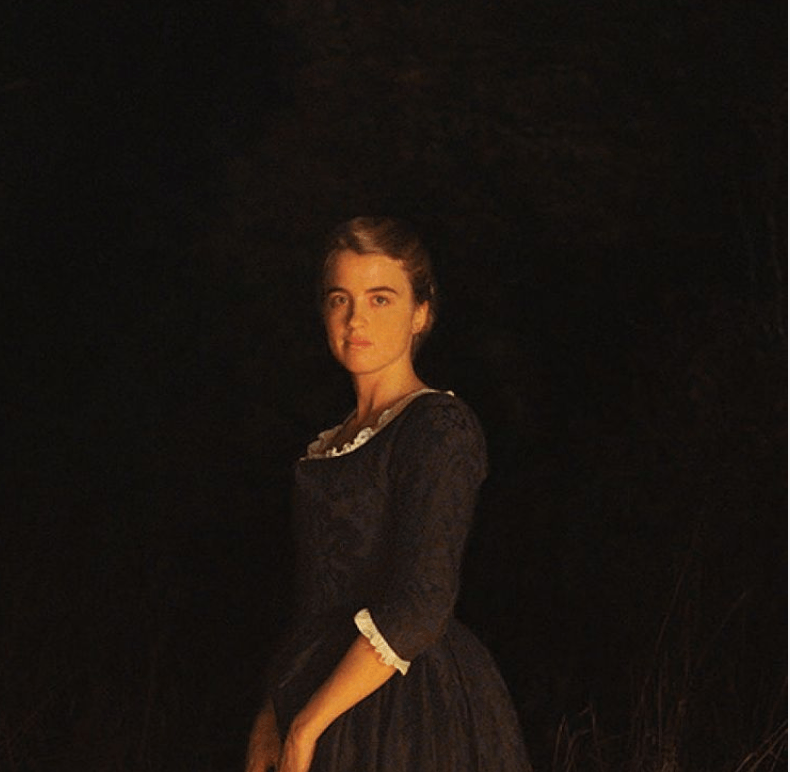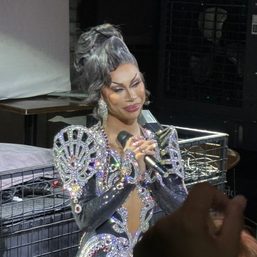SUMMARY
This is AI generated summarization, which may have errors. For context, always refer to the full article.

Editor’s note: A previous version of this article was published on Cinema Centenario’s website. Warning: spoilers ahead.
It’s been 574 days since I saw Portrait of a Lady on Fire for the first time.
I took a taxi from Katipunan to catch the first screening in Makati. When we entered, the cinema barely had an audience for the afternoon screening. I seated myself away from my friends because I wanted a cinematic experience of my own.
As soon as it ended, I sank into my chair as I cried knowing that I had seen a film you’d be lucky enough to witness at least once in your lifetime.
In this isolated island in Brittany, we encounter the faces of womanhood that have been lost and ignored throughout (cinematic) history.
Portrait of a Lady on Fire tells the story of Marianne (stunningly portrayed by Noémie Merlant), an 18th-century painter, who is commissioned to secretly paint Heloise (embodied by the brilliant Adèle Haenel), an aristocrat who refuses to pose for her wedding portrait in anticipation of her marriage to an unknown Milanese man.
As the narrative unfolds, we learn why Heloise resists being painted and see her relationship with Marianne grow closer.
Female freedom
History has always had its way in opposing female freedom, and it is wonderful to see that the narrative fights against that. Whenever men are brought into the frame, I often find myself recoiling at the image of this perfect society being disrupted.
It leaves me sometimes to wonder: What would it be like if women felt safe enough in spaces to truly bask in their liberties?
Portrait of a Lady on Fire creates a world of women whose liberation is bound with one another, who work together, and who ultimately free one another. We get to see their roles reversed (as the maid is served by the aristocrats) and their spaces temporarily rid of their class separations (as they all sleep in the same bedroom).
It’s not for the development of any male storylines and not through the kind of suffering we are accustomed (or even complicit) to seeing women go through.
Many critics have already focused on how the film deconstructs the artist and the muse, and how the rise in desire between the two lovers is captured on film through the female gaze. But what amazes me still is how the film illustrates friendship, camaraderie, and agency in a time of oppression. There is a rebellion against the patriarchal presence that looms over them, but is never truly physically present.
This is exemplified by the character of Sophie. Filipino telenovelas and countless other films have trained us to expect the maid (played by the underrated gem Luana Bajrami) to be involved in the intimate details of the lovers’ affair. Yet we get to know that she is busy with her own set of problems — culminating in the film’s most radical image depicting her getting an abortion as she plays with a baby beside her.
It is in these smaller, more intimate moments that I find the film quietly profound. Céline treats each of these women as humans on-screen — with agency and clarity in their objectives, desires, and needs. Sophie decides to get an abortion, Marianne defies social norms in her painting, and Heloise rejects being a passive receiver of the fate handed down to her by her deceased sister.
There are other images and details that reinforce this rebellion and this act of returning what is lost throughout the film. The costume design by Dorothée Guiraud includes subtle details such as pockets in gowns, while Claire Mathon’s visually indelible cinematography creates a painting from each frame through hues that “shouldn’t exist” for the time period but do.
This was the first film I watched from writer-director Céline Sciamma and, after this, I immediately decided to watch the rest of her filmography (on MUBI). As it turns out, her entire body of work is an ode to female narratives that often remain unseen — all told within their specific, almost solitary bubbles.
In her debut Water Lilies, she depicts the accompanying rise of desire and envy during adolescence through the tale of synchronized swimming. Her sophomore feature Tomboy, my favorite of her initial trilogy, explores the formative and stifling nature of gender and the value of siblinghood to a child new to a neighborhood. Her third film, Girlhood, is a love letter to female companionship and solidarity in times of conflict and poverty, especially for Black girls growing up in France.
To delve into these films would take another few thousand words. But what must be said is that in each of these films, she loudly proclaims “you exist!” to these women. Portrait is no different.
Love as continued emancipation
Desire manifests itself as an elemental force in water and fire. But love is that which propels them forward and outward — past these boundaries to regain agency and take ownership of their cruel fates. At first, we are led to think that these fiery flames have been snuffed out by circumstance. But in the act of retelling, recreation, and remembering, these embers live on and call for liberation of those who remain unseen.
This is a message of hope: not just for lesbian love stories, but for all forms of queer love.
Cinema has often been unkind to queer lovers. Let’s face it, if you’re an actor playing an LGBT character, you’d be lucky if you were alive by the end. Even luckier if you were happy; one in a million if loved and healthy. The mainstream audience love seeing LGBT characters suffer almost as much as they love seeing women used for the character development of men.
In most films, someone either dies from a disease, returns to a “loveless” relationship, or “breaks up” due to societal pressure and eventually leads a miserable life. In the end, only one of them is left and we remain to deal with the shambles; unable to comfort them through the black mirror that separates us. Why is it that lovers are treated as stepping stones rather than as human beings?
Portrait of a Lady on Fire presents something new among this sea of narratives: in its refusal to classify itself as a “happy” or “sad” ending, it has crafted a depiction of love as continued emancipation, even in its apparent dissolution. Céline proposes and fights for a love that always has a future.
From the personal to the communal
Often, we look for films that are mirrors of our realities, but cinema also exists as a reimagining of reality. This has never been truer than in this film, which has a “meta” aspect from its inception. Céline creates her most creative work from her most personal story — as Portrait is written as a reconstitution of her relationship and eventual breakup with Adèle Haenel.
When I heard about this for the first time, I openly wept once. As I watched more interviews, it became clearer to me why the film was structured in this way and why it needed to be told. In a sense, Céline creates the most loving farewell to Adèle by transforming her as the muse one last time while she is the painter — together in a final act of creation.
They had met on the set of Water Lilies nearly 12 years ago and have bonded over the creation and critique of art in all its forms. Marianne and Heloise’s relationship mirrors this and the world of Portrait is created in a way that love is mediated by the presence, creation, and destruction of art.
In the scene leading up to the first ending, Heloise commands Marianne to turn around. We know that she has already memorized her face: So why turn? After much thought, I’ve come to realize that she turns around because she agrees to a pact: to make the poet’s choice, not the lover’s, together. The presence of art makes the personal experience exist in the collective, and this allows it to live on in memory and history.
Art has never been decorative and its muses have never been idle. It is the secret language spoken by lovers, but seen by the world – from which we either derive new meaning or reinforce its previous meaning. It reveals something about the personal and the political in its examination of the perspective, and is a form of communication with the world around us and back — a dialogue across space and time.
In both of the film’s endings, Marianne and Heloise reconnect once more through art: Marianne “sees” Heloise as a painting in an art gallery, while Heloise “sees” Marianne as she listens to an orchestra play Vivaldi’s The Four Seasons. Much like Céline and Adèle, our two protagonists are separated by their worldly obligations but bound together by art. In the liminal space of art, they meet and keep on meeting.
I walked in knowing nothing about the film, but I left the theater wanting to watch nothing else in the conceivable future. I wanted to stay with how it made me feel for the rest of my life. Only now do I recognize what that feeling was: emancipation.
Because it is now shared to the world, we are able to participate in this love and in heartbreak too as it is now ours too. This parallels Orpheus’ own struggles to keep Eurydice alive in the personal and collective memory as she was in the Underworld. With each listen to Vivaldi, we are now reminded of this collective heartbreak.
In writing this essay, I retell their story once again and it allows their love to live a little longer than it might have. Though the film also mocks Orpheus for turning (in the same way that Céline is likely hitting her head over this decision), we see why they turn. In their decision to lose each other, we gain something together. – Rappler.com
Portrait of a Lady on Fire is available starting June 4 at the Film Development Council of the Philippines website as part of PelikuLAYA 2021. The film is also available on demand via Hulu and the Criterion Channel.
Add a comment
How does this make you feel?
![[Rappler Investigates] Dangers of TikTok](https://www.rappler.com/tachyon/2024/04/dangers-tiktok-april-18-2024.jpg?resize=257%2C257&crop=309px%2C0px%2C1080px%2C1080px)




There are no comments yet. Add your comment to start the conversation.